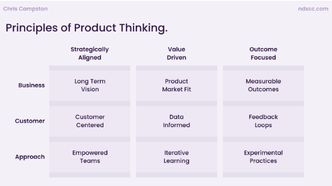
Product Thinking Mindset
Enabling a Product Thinking Mindset
Our key insights from a workshop delivered by Product Enablement & Ops Coach, Chris Compston on Enabling a Product Thinking Mindset.
What is a high performing product team?
The first question asked in the workshop was How do you define a ‘high-performing’ product team? We exchanged ideas and experiences on the essential practices of any successful product team. Unsurprisingly our experiences at different organisations - from startups to tech giants - influenced our contributions, which ranged from:
- Delivering at pace: being proactive and maintaining momentum towards a release.
- Obsessing over customers: to meet the needs, desires and preferences of customers above all else.
- Being open to failure: recognising that failure is an essential part of innovation
- KPIs: Implementing key performance indicators to represent a desired outcome.
Chris asked each team to distil our suggestions into one phrase, and it became clear we were all saying the same thing in different ways:
“We consistently get things to [customers] that they value enough to [pay for].”
Definitely not radical thinking. For anyone who has received an Amazon Prime delivery will know, this obsession with customer outcomes is the making of successful companies. Without focusing on being effective, any efficiency gain won’t be realised.
What does it mean to be effective?
- We achieve better outcomes from the things we launch
- We learn from all the outcomes of the things we launch
- We apply our learnings to achieve greater outcomes
Another thing about the workshop was the impact that alignment, between product managers, technical leads, data analysts and sales teams, on what success looks like had. They reached consensus that to be confident we are shipping the right products, in the right way we would need to increase the quality of the team’s decision making.
How do you improve the team’s decision making?
This is where Product Thinking comes into play. A set of principles or practices proven to be the fundamentals of a high performing product team.

Organising into 6 smaller groups, some working together on a regular basis whilst others had just met, we were asked to rank each of the principles of product thinking from 1 to 9 based on our levels of practice within Hometrack. This activity encouraged teams to reflect on the maturity of our product operations at Hometrack to identify opportunities for improvement. Overwhelming every team ranked Long Term Vision, Product Market Fit (particularly in automated valuations) and Customer Centricity 1-3 with some variation of order. And our biggest and tangible opportunities for improvement were Data informed, Feedback Loops and Measurable outcomes.
I have since run this same exercise with our Senior Leadership group and the outcomes were the same, giving a strong indication that if we focus on measurement and accessibility of data and feedback into our product teams they will have the insights to make better product decisions.
What was constructive about the workshop was the “Lean Capability Canvas” , a practical tool that product teams can use to reflect on their own team's maturity of product thinking and identify ways to continuously improve. The canvas facilitates the team to select a product thinking principle and to agree on their desired state:
We believe in continually striving to understand our customer
As opposed to relying on gut instinct
Therefore we are a data informed team
So that we build the right things
It then provides the framework to reflect on the team's capabilities now, what would be better and even desired, and facilitates discussion to reach a shared commitment to improve current practices and optimise and become more proficient and efficient as well as what it would look like to become a shining example to other teams.
The workshop Chris facilitated was exactly the foundation our teams needed to realise being efficient is crucial, but will only get us so far. It helped to crystallise, in a memorable way, the benefits of being effective as well as efficient and that each and every team can bring about the change necessary through continuous improvement.